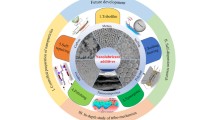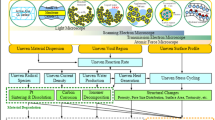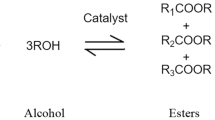Abstract
As alternative lubricant anti-wear additives are sought to reduce friction and improve overall fuel economy, it is important that these additives are also compatible with current emissions control catalysts. In the present work, a second-generation oil-miscible phosphorous-containing ionic liquid (IL), is evaluated for its impact on Pd-based three-way catalyst (TWC) reactivity and benchmarked against the industry standard zinc dialkyl-dithio-phosphate (ZDDP). The TWCs are exposed to the lubricant additives in an engine bench under four different scenarios: base case with no additive (NA), ZDDP-only, IL-only, and IL + ZDDP. The engine-aged TWC samples, along with the as-received TWC, are characterized through various analytical techniques including catalyst reactivity evaluation in a bench-flow reactor. The temperature of 50% conversion (T50) for the ZDDP-aged TWC increases by 11, 21, and 36 °C for CO, C3H6, and C3H8, respectively, as compared with the no-additive case. Similarly, the T50 for IL-only and IL + ZDDP-aged TWCs also increase as compared with the no-additive case. Even though the water-gas-shift (WGS) reactivity is similar for all engine-aged samples, the IL-aged TWC had higher oxygen storage capacity than the ZDDP-aged TWC. EPMA analysis reveals penetration of phosphorus deep into the washcoat for all engine-aged TWCs. Results from XRD indicate the presence of CePO4 and AlPO4 on the washcoat of IL, ZDDP, and IL + ZDDP-aged TWC samples but not on the fresh and NA TWC samples. Additionally, ICP-OES results show a large amount of phosphorus in the washcoat of IL, ZDDP and IL + ZDDP-aged TWC samples and a lesser amount in NA TWC samples.













Similar content being viewed by others
References
Spikes, H.: The history and mechanisms of ZDDP. Tribol. Lett. 17(3), 469–489 (2004)
Swami, K.K., Prakash, S., Mondal, P.K., Dohhen, K.C., Sarin, R., Tuli, D.K., Bhatnagar, A.K.: Additive-additive interactions: the search for synergistic antioxidant—antiwear phosphorodithioate compositions. Lubr. Sci. 14(4), 385–392 (2002)
Chamberlin, W., Zalar, F.: Balancing crankcase lubricant performance with catalyst life. SAE Technical Paper 841407, (1984). https://doi.org/10.4271/841407
Gandhi, H.S., Wlliamson, W.B., Bomback, J.L.: Deactivation of three-way and oxidation catalyst dual bed emission control systems: catalyst post mortem analyses from methanol-fueled vehicles. Appl. Catal. 3(1), 79–88 (1982)
Rokosz, M.J., Chen, A.E., Lowe-Ma, C.K., Kucherov, A.V., Benson, D., Paputa Peck, M.C., McCabe, R.W.: Characterization of phosphorus-poisoned automotive exhaust catalysts. Appl. Catal. B Environ. 33(3), 205–215 (2001)
Xu, L., Guo, G., Uy, D., O’Neill, A.E., Weber, W.H., Rokosz, M.J., McCabe, R.W.: Cerium phosphate in automotive exhaust catalyst poisoning. Appl. Catal. B Environ. 50(2), 113–125 (2004)
Larese, C., Cabello Galisteo, F., López Granados, M., Mariscal, R., Fierro, J.L.G., Furió, M., Fernández Ruiz, R.: Deactivation of real three way catalysts by CePO4 formation. Appl. Catal. B Environ. 40(4), 305–317 (2003)
Uy, D., O’Neill, A.E., Xu, L., Weber, W.H., McCabe, R.W.: Observation of cerium phosphate in aged automotive catalysts using Raman spectroscopy. Appl. Catal. B Environ. 41, 269–278 (2003)
Angelidis, T.N., Sklavounos, S.A.: A SEM-EDS study of new and used automotive catalysts. Appl. Catal. A Gen. 133, 121–132 (1995)
Today, C., Spanish, G., Cabello, F., Organizaci, G., Mariscal, R., National, S.: Effect of mileage on the deactivation of vehicle-aged three-way catalysts. Catal. Today. 107-108, 77–85 (2005). https://doi.org/10.1016/j.cattod.2005.07.064
Angove, D.E., Cant, N.W., Bailey, G.M., Cohen, D.D.: The application of PIXE to the mapping of contaminants deposited on a monolithic automotive catalytic converter. Nucl. Instruments Methods Phys. Res. Sect. B Beam Interact. with Mater. Atoms. 109, 563–568 (1996)
Welton, T.: Room-temperature ionic liquids. Solvents for synthesis and catalysis. Chem. Rev. 99, 2071–2083 (1999)
Earle, M., Seddon, K.: Ionic liquids. Green solvents for the future. Pure Appl. Chem. 72(7), 1391–1398 (2000)
Olivier, H.: Recent developments in the use of non-aqueous ionic liquids for two-phase catalysis. J. Mol. Catal. A Chem. 146(1-2), 285–289 (1999)
Jiménez, A.E., Bermúdez, M.D.: Imidazolium ionic liquids as additives of the synthetic ester propylene glycol dioleate in aluminium-steel lubrication. Wear. 265(5-6), 787–798 (2008)
Yao, M., Liang, Y., Xia, Y., Zhou, F.: Bisimidazolium ionic liquids as the high-performance antiwear additives in poly(ethylene glycol) for steel-steel contacts. ACS Appl. Mater. Interfaces. 1(2), 467–471 (2009)
Cai, M., Liang, Y., Yao, M., Xia, Y., Zhou, F.: Imidazolium ionic liquids as antiwear and antioxidant additive in poly (ethylene glycol) for steel/steel contacts. ACS Appl. Mater. Interfaces. 2(3), 870–876 (2010)
Libardi, A., Schmid, S.R., Sen, M., Schneider, W.: Evaluation of ionic fluids as lubricants in manufacturing. J. Manuf. Process. 15(4), 414–418 (2013)
Shah, F.U., Glavatskih, S., MacFarlane, D.R., Somers, A., Forsyth, M., Antzutkin, O.N.: Novel halogen-free chelated orthoborate–phosphonium ionic liquids: synthesis and tribophysical properties. Phys. Chem. Chem. Phys. 13(28), 12865–12873 (2011)
Battez, A.H., Bartolomé, M., Blanco, D., Viesca, J.L., Fernández-González, A., González, R.: Phosphonium cation-based ionic liquids as neat lubricants: physicochemical and tribological performance. Tribol. Int. 95, 118–131 (2016)
Barnhill, W.C., Qu, J., Luo, H., Meyer, H.M., Ma, C., Chi, M., Papke, B.L.: Phosphonium-organophosphate ionic liquids as lubricant additives: effects of cation structure on physicochemical and tribological characteristics. ACS Appl. Mater. Interfaces. 6(24), 22585–22593 (2014)
Qu, J., Bansal, D.G., Yu, B., Howe, J.Y., Luo, H., Dai, S., Li, H., Blau, P.J., Bunting, B.G., Mordukhovich, G., Smolenski, D.J.: Antiwear performance and mechanism of an oil-miscible ionic liquid as a lubricant additive. ACS Appl. Mater. Interfaces. 4(2), 997–1002 (2012)
Qu, J., Luo, H., Chi, M., Ma, C., Blau, P.J., Dai, S., Viola, M.B.: Comparison of an oil-miscible ionic liquid and ZDDP as a lubricant anti-wear additive. Tribol. Int. 71, 88–97 (2014)
Yu, B., Bansal, D.G., Qu, J., Sun, X., Luo, H., Dai, S., Blau, P.J., Bunting, B.G., Mordukhovich, G., Smolenski, D.J.: Oil-miscible and non-corrosive phosphonium-based ionic liquids as candidate lubricant additives. Wear. 289, 58–64 (2012)
Zhou, Y., Dyck, J., Graham, T.W., Luo, H., Leonard, D.N., Qu, J.: Ionic liquids composed of phosphonium cations and organophosphate, carboxylate, and sulfonate anions as lubricant antiwear additives. Langmuir. 30(44), 13301–13311 (2014)
Otero, I., López, E., Reichelt, M.: Ionic liquids based on phosphonium cations as neat lubricants or lubricant additives for a steel/steel contact. ACS Appl. Mater. Interfaces. 6(15), 13115–13128 (2014)
Somers, A.E., Khemchandani, B., Howlett, P.C., Sun, J., Macfarlane, D.R., Forsyth, M.: Ionic liquids as antiwear additives in base oils: influence of structure on miscibility and antiwear performance for steel on aluminum. ACS Appl. Mater. Interfaces. 5(22), 11544–11553 (2013)
Qu, J., Luo, H., Toops, T.J., West, B.H., Blau, P.J., Dai, S., Papke, B.L., Gao, H., Kheireddin, B., Chen, C.: Ionic Liquids as Multi-Functional Lubricant Additives to Enhance Engine Efficiency (final report NFE-12-03876). (Oak Ridge National Laboratory (ORNL), Oak Ridge, TN (United States). Center for Nanophase Materials Sciences (CNMS) (2016). https://doi.org/10.2172/1246776
Xie, C., Toops, T.J., Lance, M.J., Qu, J., Viola, M.B., Lewis, S.A., Leonard, D.N., Hagaman, E.W.: Impact of lubricant additives on the physicochemical properties and activity of three-way catalysts. Catalysts. 6, 54 (2016)
West, B., Sluder, C.S.: Lubricating oil consumption on the standard road cycle. SAE technical Paper Series 2013-01-0884 (2013). https://doi.org/10.4271/2013-01-0884
Kenneth, G., Rappé, Craig DiMaggio., Josh, A., Pihl, Joseph R., Theis, Se. H. Oh., Galen, B., Fisher, Jim Parks, Vencon G. Easterling, Ming Yang, Mark L. Stewart, Kenneth C. Howden, “Aftertreatment Protocols for Catalyst Characterization and Performance Evaluation: Low-Temperature Oxidation, Storage, Three-Way, and NH3-SCR Catalyst Test Protocols,” Emission Control Science and Technology 5(2) 183–214 (2019)
Larese, C., Galisteo, F.C., Granados, M.L., Mariscal, R., Fierro, J.L.G.: Effects of the CePO 4 on the oxygen storage and release properties. 226(2), 443–456 (2004)
Angelidis, T. N., Koutlemani, M. M., Sklavounos, S. A., Lioutas, C. B., Voulgaropoulos, A., Papadakis, V. G., & Emons, H.: Causes of deactivation and an effort to regenerate a commercial spent three-way catalyst. In Studies in surface science and catalysis. 116, 155–164 (1998)
Acknowledgements
This work was supported by the U.S. Department of Energy (DOE), Vehicle Technologies Program. The authors gratefully acknowledge the support and guidance of program managers Gurpreet Singh, Kevin Stork, Ken Howden, and Mike Weismiller at DOE.
Author information
Authors and Affiliations
Corresponding author
Ethics declarations
The authors declare that they have no competing interests.
Additional information
Publisher’s Note
Springer Nature remains neutral with regard to jurisdictional claims in published maps and institutional affiliations.
This manuscript has been authored by UT-Battelle, LLC, under contract DE-AC05-00OR22725 with the US Department of Energy (DOE). The US government retains and the publisher, by accepting the article for publication, acknowledges that the US government retains a nonexclusive, paid-up, irrevocable, worldwide license to publish or reproduce the published form of this manuscript, or allow others to do so, for US government purposes. DOE will provide public access to these results of federally sponsored research in accordance with the DOE Public Access Plan (http://energy.gov/downloads/doe-public-access-plan).
Rights and permissions
About this article
Cite this article
Kim, D., Toops, T.J., Nguyen, K. et al. Impact of Lubricant Oil Additives on the Performance of Pd-Based Three-Way Catalysts. Emiss. Control Sci. Technol. 6, 139–150 (2020). https://doi.org/10.1007/s40825-019-00138-x
Received:
Revised:
Accepted:
Published:
Issue Date:
DOI: https://doi.org/10.1007/s40825-019-00138-x




